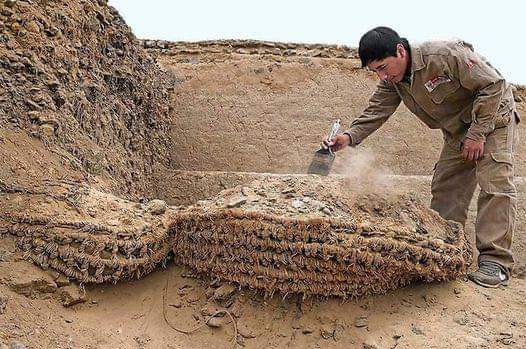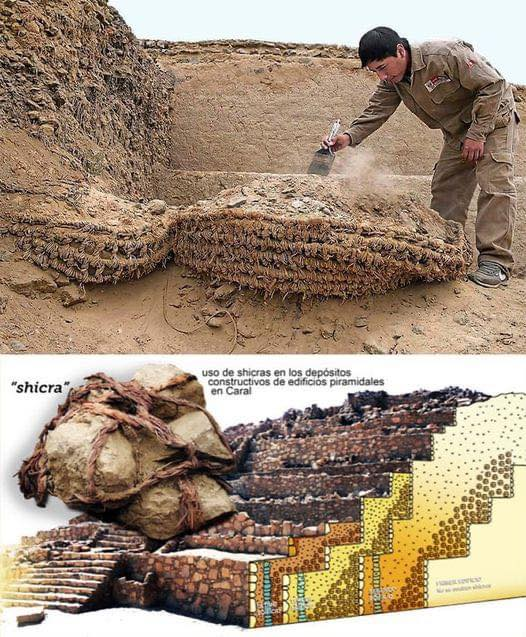Nestled in the heart of Peru, amidst the cradles of ancient civilizations, lies a groundbreaking innovation that predates modern engineering marvels: the Shicras. This remarkable anti-seismic technology, developed over 5,000 years ago by the Caral-Supe civilization, exemplifies humanity’s timeless ingenuity in adapting to the forces of nature. Long before contemporary earthquake-resistant construction, the Caral-Supe people devised a system to safeguard their structures against seismic activity, showcasing their profound understanding of engineering and environmental adaptation.
The Caral-Supe Civilization: A Window Into the Past
Dating back to around 3000 BCE, the Caral-Supe civilization is among the oldest known in the Americas. Located in the Supe Valley, roughly 200 kilometers north of modern Lima, the ancient city of Caral has been recognized as a UNESCO World Heritage Site and remains one of the most important archaeological discoveries in the region.
Caral-Supe’s society was renowned for its monumental architecture, including pyramids, plazas, and sophisticated urban layouts. Amid these architectural achievements, the Shicra system stands out as a testament to their advanced engineering and their ability to adapt to a seismically active environment.

What Are Shicras?
Shicras are woven baskets made from vegetable fibers, such as reeds or other locally sourced plants, filled with stones. Ingeniously, these baskets were not merely used as construction materials but served as a highly effective anti-seismic foundation system.
The use of Shicras demonstrates an understanding of principles that resonate with modern earthquake-resistant designs: flexibility, energy dissipation, and weight distribution.
How Shicras Mitigate Seismic Risk
The Shicra system worked by absorbing and redistributing seismic energy. When an earthquake struck, the stones within the Shicras acted as a cushion, buffering the impact of the tremors and protecting the structures from collapse.
Additionally, these baskets stabilized the soil and evenly distributed the weight of the buildings across their foundations, further reducing structural vulnerability. This integration of natural materials and ingenious design allowed Caral-Supe’s architecture to withstand the frequent earthquakes of the region for centuries.

A Sustainable Solution Ahead of Its Time
What makes the Shicra system particularly remarkable is its sustainability. The Caral-Supe civilization utilized materials readily available in their environment—reeds, stones, and other natural fibers. By relying on these local resources, they minimized their ecological footprint while creating structures perfectly suited to their landscape and its challenges.
This innovation reflects not only their technological advancement but also their deep connection with the environment, a harmony that modern societies often strive to replicate.
A Legacy of Resilience and Ingenuity
The Shicra technique offers a powerful reminder of humanity’s ability to adapt to nature’s challenges. Far from being primitive, ancient civilizations like Caral-Supe exhibited an understanding of engineering principles that continues to inspire modern architects and engineers. Researchers have begun to explore how ancient techniques, like Shicras, could influence contemporary earthquake-resistant designs, particularly in the pursuit of sustainable and resilient urban construction.
Lessons for the Future
In an era of rapid urbanization and growing climate-related risks, the rediscovery of Shicras is timely. By integrating ancient knowledge with modern technologies, we can create safer, more sustainable structures that honor the ingenuity of past civilizations. The Caral-Supe’s legacy underscores the value of looking to history for solutions to today’s challenges.
Conclusion
The 5,000-year-old Shicras of the Caral-Supe civilization are more than an engineering marvel; they are a symbol of humanity’s enduring quest to innovate and thrive in harmony with nature. As we marvel at the wisdom of these ancient builders, we are reminded that sometimes, the key to progress lies in the lessons of the past. The Shicras are not just a relic of history—they are a beacon of sustainable ingenuity for the future.

